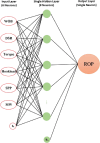Predicting the Rate of Penetration while Horizontal Drilling through Unconventional Reservoirs Using Artificial Intelligence
- PMID: 39713651
- PMCID: PMC11656353
- DOI: 10.1021/acsomega.4c08006
Predicting the Rate of Penetration while Horizontal Drilling through Unconventional Reservoirs Using Artificial Intelligence
Abstract
Estimating the rate of penetration (ROP) is one of most critical tasks for evaluating the efficiency and profitability of drilling operation, which will aim in decision-making related to well planning, time estimation, cost estimation, bit selection, operational troubles, and logistics in drilling operation. The rise in unconventional resource development underscores the need for accurate ROP prediction to optimize drilling operations in these valuable reserves. ROP prediction and optimization in unconventional hydrocarbon reservoirs are challenging due to the formations' heterogeneity, high strength, and brittleness. These reservoirs often involve complex well designs, high pressures, and high temperatures, making it difficult to maintain optimal drilling conditions. This study presents the optimization and validation of the artificial neural network (ANN) model to predict the ROP during horizontal drilling through unconventional hydrocarbon reservoirs. The ANN model was trained using 34,869 data points from five wells (Well-1 to Well-5) and achieved a high correlation coefficient of 0.96 and an average absolute percentage error (AAPE) of 4.68%. An empirical correlation was developed based on the weights and biases of the optimized ANN model. The empirical correlation performance was rigorously tested with 23,246 data points, representing 40% of the data from the same wells, yielding an AAPE of 4.75% and a correlation coefficient of 0.96. Validation of the developed equation on data from Well-6 further confirmed the model's robustness, maintaining a correlation coefficient of 0.91 and an AAPE of 5.75%. These results demonstrate the ANN model's and empirical equation's accuracy and reliability in predicting the ROP, highlighting their potential to optimize drilling operations in unconventional hydrocarbon reservoirs.
© 2024 The Authors. Published by American Chemical Society.
Conflict of interest statement
The authors declare no competing financial interest.
Figures





Similar articles
-
A New Model for Predicting Rate of Penetration Using an Artificial Neural Network.Sensors (Basel). 2020 Apr 6;20(7):2058. doi: 10.3390/s20072058. Sensors (Basel). 2020. PMID: 32268597 Free PMC article.
-
Real-Time Prediction of Rate of Penetration in S-Shape Well Profile Using Artificial Intelligence Models.Sensors (Basel). 2020 Jun 21;20(12):3506. doi: 10.3390/s20123506. Sensors (Basel). 2020. PMID: 32575868 Free PMC article.
-
Real-time prediction of formation pressure gradient while drilling.Sci Rep. 2022 Jul 5;12(1):11318. doi: 10.1038/s41598-022-15493-z. Sci Rep. 2022. PMID: 35790798 Free PMC article.
-
Machine Learning Models for Equivalent Circulating Density Prediction from Drilling Data.ACS Omega. 2021 Oct 5;6(41):27430-27442. doi: 10.1021/acsomega.1c04363. eCollection 2021 Oct 19. ACS Omega. 2021. PMID: 34693164 Free PMC article.
-
Real-Time Measurement of Drilling Fluid Rheological Properties: A Review.Sensors (Basel). 2021 May 21;21(11):3592. doi: 10.3390/s21113592. Sensors (Basel). 2021. PMID: 34064161 Free PMC article. Review.
References
-
- Najibi A. R.; Ghafoori M.; Lashkaripour G. R.; Asef M. R. Reservoir geomechanical modeling: In-situ stress, pore pressure, and mud design. J. Pet. Sci. Eng. 2017, 151, 31–39. 10.1016/j.petrol.2017.01.045. - DOI
-
- Mahmoud A. A.; Elzenary M.; Elkatatny S. New hybrid hole cleaning model for vertical and deviated wells. J. Energy Resour. Technol. 2020, 142, 03450110.1115/1.4045169. - DOI
-
- Adams N.; Charrier T.. Drilling Engineering: A Complete Well Planning Approach; PennWell Publishing Company: 1985.
-
- Osman H.; Ali A.; Mahmoud A. A.; Elkatatny S. Estimation of the rate of penetration while horizontally drilling carbonate formation using random forest. J. Energy Resour. Technol. 2021, 143, 09300310.1115/1.4050778. - DOI
-
- Hegde C.; Gray K. E. Use of machine learning and data analytics to increase drilling efficiency for nearby wells. J. Nat. Gas Sci. Eng. 2017, 40, 327–335. 10.1016/j.jngse.2017.02.019. - DOI
LinkOut - more resources
Full Text Sources
